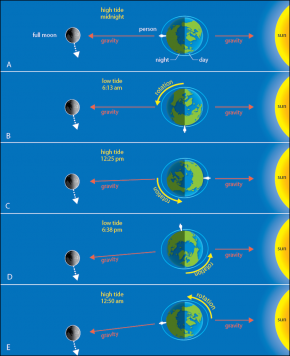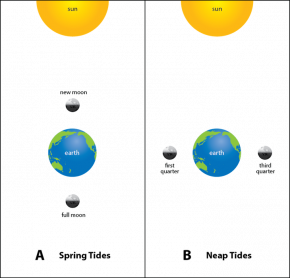Tide Formation—Gravitational Pull
Gravity
Gravity is the force of attraction between any two objects. Gravity is directly proportional to the mass of the objects, and inversely proportional to the square of the distance between them. This means that an object that has more mass can exert more gravitational force on another object, and the closer two objects are to one another, the greater the force of attraction between them. This relationship can be expressed by the following equation:
|
|
Fg is the gravitational force, G is the gravitational constant, m1 and m2 are the masses of two objects, and r is the distance between the objects’ centers of mass. Although there are gravitational forces between all massive objects, the gravitational force between the earth and objects on its surface is much larger than the gravitational forces between any of those objects because of the earth’s massive size. Gravity is the reason why earth has an atmosphere. Gravity is also the reason why people stay on the surface of the earth, and why objects fall to the ground when dropped.
Gravitational Pull of the Moon
Fig. 6.5. The moon’s gravitational force acting upon the ocean causes lunar tides. Tidal bulges in the ocean are exaggerated in this figure to show the effects of gravitational forces.
Image by Byron Inouye
Gravity is also the cause of tides. The earth’s gravity keeps water on the planet’s surface. However, the moon is large enough and close enough that its gravitational force has a noticeable effect on large bodies of water on Earth. Water on Earth in the region directly beneath the moon is pulled by gravitational force toward the moon (Fig. 6.5), creating a bulge on the surface of the ocean. There is also a bulge on the opposite side of the earth, caused by the difference in the moon’s gravitational force across the earth. The ocean bulges on both the side of the earth facing the moon and the side opposite the moon are called tidal bulges. Earth’s land surface also bulges, as does the moon, although not to the same extent as the ocean.
Tidal bulges are very small—seemingly insignificantly small—compared to the radius of the earth. The tidal bulges in figures in this unit are greatly exaggerated. The height of the tidal bulge in the open-ocean is less than a meter in most areas. However, because the ocean is so vast, tidal bulges can raise a huge amount of water. The tide resulting from the moon’s gravitational pull is called the lunar tide.
Fig. 6.6. Tides at various times of the day as the earth rotates during a full moon (North Pole view). The observer’s local time is indicated (note that the person is standing on the equator). Distance and sizes of the earth, the moon, and the sun are not to scale. (A) High tide at midnight (B) Low tide at 6:13 a.m. (C) High tide at 12:25 p.m. (D) Low tide at 6:38 p.m. (E) High tide at 12:50 a.m.
Image by Byron Inouye
The moon moves very little around the earth each day. During one day, the earth makes a complete rotation on its axis, while it takes the moon almost a month to orbit around the earth. In Fig. 6.6, we can see that this means the earth rotates through the tidal bulges. At midnight, a person standing on the shore of the ocean near the equator would see a high tide, caused by the gravitational force of the moon (Fig. 6.6 A). If that person remained in the same location over the course of a full day as the earth rotated, the person would move into a region of low tide at 6:13 a.m. This is because the place on Earth where she is standing would have rotated into the trough in between the two tidal bulges (Fig. 6.6 B). At 12:25 p.m. there would be another high tide, caused by the outward force of the Earth’s rotation. Fig. 6.6 C). At 6:38 p.m. there would be another low tide (Fig. 6.6 D), and at 12:50 a.m. another high tide (Fig. 6.6 E).
Because the moon progresses about 12 degrees (Лљ) in its orbit around the earth during each 24-hour period, and because it rotates in the same direction as Earth rotates, the moon will not be directly overhead of the observer again until it completes one rotation and is again full. This explains why, for any given observer on the surface of the earth, the moon appears to rise about 50 minutes later each day and why the time of the high and low tides is about 50 minutes later each day. This also explains why the fictional person described in the previous paragraph in Fig. 6.6 observed high and low tides about six hours and 12.6 minutes apart.
Gravitational Pull of the Sun
The sun also exerts a gravitational force on the earth, producing a solar tide. Just like with the earth and the moon, water on Earth directly in line with the sun is pulled by gravitational force toward the sun, creating a bulge of water. There is also a bulge on the side of the earth opposite the sun. Similar to the lunar tide, as the earth rotates through the bulge of water produced by the sun, the tide level changes from high to low and back again. Because the earth rotates every 24 hours, solar tidal changes occur on a 24-hour schedule.
Interactions of the Gravitational Pulls of the Moon and Sun
Even though the mass of the sun is much greater than the mass of the moon, the moon has a greater influence on the tides than the sun. This is because the sun is much farther away from the earth, so its tidal force is only about half that of the moon. Gravitational force depends on both the mass of the objects and the distance between them.
Fig. 6.7. (A) spring tides (B) neap tides
Image by Byron Inouye
Because the moon moves a little farther each day in its orbital journey around the earth, the tides caused by the moon’s gravity occur 50 minutes later than the tides caused by the sun’s gravity. It takes the moon about 29.5 days to complete its orbit around the earth. This period is called a lunar month. The moon and the sun cause predictable, periodic changes in tidal range during a lunar month. Therefore a lunar month is also called a tidal month.
When the earth, moon, and the sun are lined up, lunar and solar tides occur at nearly the same time and produce the largest tidal ranges over the lunar month. They occur during the new moon, when the moon is between the earth and the sun, or full moon, when the earth is between the moon and the sun (Fig. 6.7). Extra-high and extra-low tides occur at this time. They are called spring tides because they “jump” or “spring” up. When the sun and moon are at a right angle (90˚) to each other, the moon is either in its first quarter or its third quarter. In this position the solar and lunar tides tend to cancel each other out, and a reduced tide, called a neap tide, occurs (Fig. 6.7). There are two spring tides and two neap tides in a tidal month.











